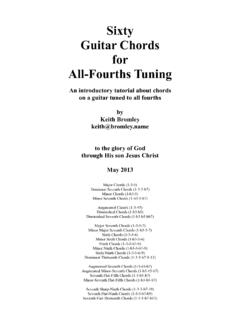Transcription of Guitar Notes for Beginners
1 Guitar Notes for Beginners Written by Bobby Kittleberger Property of Guitar Chalk Media LLC Live URL: The simplest building block of music, and one that unfortunately is often overlooked by beginning Guitar players, is the single note. Before you get into scales, chords, melody or songs, Guitar Notes should be fully understood which, in turn, will allow a Guitar student to develop a more complete understanding of the following concepts: Fretboard Navigation chord Composition Guitar Scales In this lesson I'll cover Guitar Notes in full, which will take us through a basic definition, some applicable music theory and then a process for complete fretboard memorization. WHAT YOU WILL LEARN What Guitar Notes are What Guitar chords are Naturals, sharps and flats Fretboard memorization Let's start with a working definition of a Guitar note before we get into more nuanced issues. Checkout Suppl ement al Courses t o t his Lesson Want to put your Guitar Notes to work?
2 Guitar Tricks has a library of over 11,000 professional, full Guitar lessons shot in crystal clear HD video and sectioned into properly ordered courses. Check 'em 800 song tutorials with licensed tab sheets 11,000 plus HD video lessons Award winning curriculum In the business of building Guitar courses since 1998 USE THE FREE TRIAL Guitar Tricks will let you try their membership 14 days free, with an additional 60 days after that to cancel with a full refund. Checkout the FREE trial OR, TRY THE PROMOTIONAL OFFER Current Deal: Use the promo code 60 OFF for 60 percent off your first month's membership. Use the 60 OFF promo code Basic Definit ion A Guitar note can be defined as a single tone or pitch which, on the Guitar , can either be a fretted note or an open string. Several Notes sounding in a chronological order (either ascending or descending) are how you get melody and scales, while several Notes sounding in unison would create a chord .
3 A Guitar note is a single pitch sounding from either an open or fretted string. Lines of single Notes create melody and/or Guitar scales Groups of Notes played in unison create chords These Notes are assigned a letter value that's used to indicate pitch. That letter will always be one of the following: A, B, C, D, E, F, G These are called natural Notes , meaning they don't have any sharps or flats associated with them (more on sharps and flats later). Here are a couple examples of how you might see Notes identified in a tab or Guitar chord diagram: Identifying Notes in a Guitar chord diagram. (View Larger Image) And for a line of single Notes (melody) in a Guitar tab Identifying Notes in a Guitar tab. (View Larger Image) Now that we've established a basic definition, we can look at Guitar Notes in different contexts and learn how to actually use them. We'll start with the Notes for open strings in a standard tuning.
4 Guit ar Not es for Each Open Guit ar St ring in a St andard Tuning In a standard tuning, each string has an "open" note value, which is the letter of the note when it's played without pressing down any frets. This pattern goes from the lowest (thickest) string, to the highest, as follows: E - A - D - G - B - E Guitar Notes for each string in a standard tuning. (View Larger Image) Here's how it sounds, from low to high: Here's how the Notes would look in a Guitar tab and formal music sheet: Guitar Notes for open strings, left to right (low to high): E - A - D - G - B - E (View Larger Image) For those who are familiar with the term, Guitar Notes for the drop D tuning should also be covered. Not es for Each Guit ar St ring in Drop D In the drop D tuning, which is commonly used in modern rock, the low E string is tuned down to a D note (one whole step), which then gives you the following note arrangement for your open strings: Guitar Notes for each string in drop D.
5 (View Larger Image) In the audio sample, you can hear that the two D Notes now sound the same: The tabs and sheet music: Guitar Notes for open strings in the drop D tuning, left to right (low to high): D - A - D - G - B - E. (View Larger Image) Memorizat ion Techniques While there are acronyms you can use to memorize the open Notes for the Guitar , I always thought they seemed kind of childish and I personally don't like using them. Besides, it's only six Notes , which doesn't take long to remember, even if you go at it head on without an aid or acronym. You'll also notice that tuning the Guitar requires you getting really familiar with these six Notes , which can alone help with memorization. I'd recommend using Fender's online tuner to tune up and get familiar with the open Notes . Not es and Chords: How t hey Rel at e As we've already seen, Notes are a letter value of a single pitch on the Guitar , which can either be an open string or a freted note.
6 Those single pitches can be grouped into multiple Notes sounding in unison, which give us chords. For example, the open C major chord is made up of four Notes : C - E - G - C (octave) Here's how those Notes look in a chord diagram: The single Notes in a C chord : C - E - G - C. (View Larger Image) If we pulled these Notes out of the chord and played them one at a time (this is called an arpeggio), the Notes would show up in a Guitar tab like this: Notes in the C chord diagram corresponding to single Notes in a tab. (View Larger Image) You can check out the following resources if you need help reading the chord or tab diagrams: Guitar chord Resource (how to read chord diagrams) Guitar Tab Resource (how to read Guitar tabs - near the end of the article) Now that we've covered some basics about reading Notes and interpreting them in both a tab and diagram, let's look at the differences between natural Notes , sharps and flats.
7 Underst anding Nat ural Not es As I've already mentioned, natural Notes are those that do not have either a sharp or flat attached to them. This means that all natural Notes will be one of the following: A, B, C, D, E, F, G If we go back to our acoustic Guitar graphic, we can use the fretboard dots to easily identify natural Notes . I highly recommend you take the time to memorize these Notes first, at least for the low E string. Start with the Notes on the low E string at each fret marked by a dot, plus F, C and D (located at frets that traditionally don't have dots), up to the 12th fret: Notes for the sixth string based on fretboard dots. (View Larger Image) Here's how it would look on a tab sheet: Natural Notes for the sixth string in a Guitar tab. (View Larger Image) And the audio: Memorizing the position of the natural Notes on the fretboard for the sixth string is an important first step, because it helps you utilize the fretboard dots and gets you familiar with many of the root Notes for common chords.
8 At that point, the fretboard dots can serve as a quick reference point for finding natural Notes . Once you've gotten familiar with the concept of natural Notes , we can then place sharps and flats in relation to each natural note. Underst anding Sharps and Fl at s In order to understand sharps and flats, it's helpful to first cover a quick definition of a half step and whole step: Half Step: A change in pitch equaling one semitone (one fret) Whole Step: A change in pitch equaling one whole tone (two frets) Changes in pitch are measured in half and whole step increments. Thus, you can understand sharps and flats as the following: Sharp: Change in pitch one half step higher Flat: Change in pitch one half step lower Again, this occurs in relation to natural Notes . For example, if you start with F and raise the pitch one half step, you get F . Likewise if you're looking at B, and you lower the pitch by one half step, you get B.
9 Example of a sharp and flat note on the fretboard. (View Larger Image) One question that might come up is why we wouldn't call these Notes A or G . The reason is that it's not theoretically correct to say that G and F are the same Notes . They are actually different Notes . It's a small, very nuanced difference that has to do with what direction you tune from. However, on the Guitar , the sharps and flats are set in stone based on fret position, meaning you've simply got to memorize it the way it is. Here's a full diagram of the Notes on the sixth string, including naturals, sharps and flats: All the Notes for the sixth string from the first to the 12th fret. (View Larger Image) Now that we've covered the difference between natural Notes , sharps and flats, we can look at diagrams and methods for note memorization of the entire fretboard. It's easier and quicker than you might think. St ring by St ring Memorizat ion When it comes to Guitar fretboard memorization, you need to take one string at a time and consider the Notes at each fret up to the 12th fret, at which point the pattern repeats itself over again.
10 Keep in mind, the pattern is the same on each string, but it starts at a different note (per our section on open string Notes ). In other words, the sixth string starts with E and ascends through a pattern, while the fifth string starts at A, ascending through the same pattern. We already covered the E string Notes , so let's start this section with a diagram for the A string Notes : Memorizing t he A St ring Notes for the A string on the Guitar . (View Larger Image) In the above diagram it's assumed that the open string rings an A note, followed by B , B, C and so on, up to the 12th fret where the pattern repeats. Memorizing t he D St ring D string Notes on a Guitar fretboard. (View Larger Image) We repeat the diagram for the G string: Memorizing t he G St ring G string Notes on the Guitar fretboard. (View Larger Image) And the B string: Memorizing t he B St ring B string Notes on the Guitar fretboard. (View Larger Image) We don't need another diagram for the high E string (the thinnest string) because it matches the pattern of the low E string.











